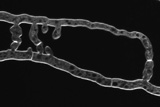Professor Emerita
Ph.D. University of California-Davis, 1986
Cell specialization, cell communication and nonself recognition are crucial mechanisms in filamentous fungi. Neurospora crassa's experimental tractability make it a superb system to address microbial communication questions. We study communication and self-signaling mechanisms mediating hyphal fusion, and nonself recognition mechanisms resulting in programmed cell death. We use molecular biology, genetics, cell biology, genomics and bioinformatics to investigate the molecular and cellular basis of nonself recognition during the filamentous fungi lifecycle.
Molecular Genetics of Filamentous Fungi
Cell specialization, cell communication and nonself recognition are crucial mechanisms in microbial organisms such as filamentous fungi. In filamentous fungi, growth occurs by hyphal tip extension, branching and repeated fusion of hyphae, ultimately forming an exquisitely connected network, from which the individual colony grows and reproduces. My research interests are focused on understanding communication and signaling mechanisms that mediate the hyphal fusion process and nonself recognition mechanisms that occur before and after hyphal fusion. The experimental tractability and availability of a large number of mutants in the filamentous fungus, Neurospora crassa, makes it a superb system to delineate both fungal-specific and general mechanisms of cell communication and nonself recognition. We use a combination of molecular biology, genetics, cell biology, genomics and bioinformatics to investigate the molecular and cellular basis of nonself recognition during both sexual and asexual phases of growth in filamentous fungi.
Nonself Recognition and Programmed Cell Death
Self/nonself discrimination is a ubiquitous and essential function of both multicellular and microbial species, and is an aspect of biology that has long fascinated scientists. Nonself recognition in filamentous fungi is mediated by differences at het (for heterokaryon incompatibility) loci. Hyphal fusion between two individuals that have genetic differences at het loci triggers programmed cell death (PCD)of the fusion cell. Nonself recognition and PCD functions to prevent transfer of mycoviruses and senescence plasmids between fungal individuals within a population. Our current research objectives include elucidating the molecular mechanism of nonself recognition, understanding how nonself recognition triggers fungal PCD and investigations into the evolution of nonself recognition systems in fungi.
Germling and hyphal fusion
 The ability to form a hyphal network is a hallmark of filamentous fungi. In filamentous ascomycete species such as Neurospora crassa, an individual hypha (a multinucleate, multicellular filament with incomplete crosswalls, or septa) grows by hyphal tip extension and branching. Behind the growing colony margin, fusions between hyphae are continuously formed (a process called anastomosis), yielding a network of interconnected hyphae, or mycelium, that makes up the fungal individual. Although the capacity to form a hyphal network is ubiquitous in filamentous fungi, little is known about the mechanism or function of an interconnected hyphal network. We have characterized a number of hyphal and germling fusion mutants in N. crassa, including strains with lesions in genes encoding MAP kinase signal transduction components and a number of transcription factors. Our current research objectives include determining the molecular mechanism of self-signling and the nature of the signaling molecules, the relationship of the signal transduction pathway to the fungal cytoskeleton and identifying target genes of transcription factors which are required for the germling and fusion process.
The ability to form a hyphal network is a hallmark of filamentous fungi. In filamentous ascomycete species such as Neurospora crassa, an individual hypha (a multinucleate, multicellular filament with incomplete crosswalls, or septa) grows by hyphal tip extension and branching. Behind the growing colony margin, fusions between hyphae are continuously formed (a process called anastomosis), yielding a network of interconnected hyphae, or mycelium, that makes up the fungal individual. Although the capacity to form a hyphal network is ubiquitous in filamentous fungi, little is known about the mechanism or function of an interconnected hyphal network. We have characterized a number of hyphal and germling fusion mutants in N. crassa, including strains with lesions in genes encoding MAP kinase signal transduction components and a number of transcription factors. Our current research objectives include determining the molecular mechanism of self-signling and the nature of the signaling molecules, the relationship of the signal transduction pathway to the fungal cytoskeleton and identifying target genes of transcription factors which are required for the germling and fusion process.
Plant cell wall deconstruction by Neurospora crassa
 In nature, filamentous fungi are the primary degraders of plant biomass. Plant biomass is a potential source for the production of biofuels. Neurospora crassa is an efficient degrader of plant cellulose and hemicellulose and is found in nature primarily on grasses. In a project funded by the Energy Biosciences Institute, we are using the genomic and genetic tools available with N. crassa to decipher transcriptional, secretory and enzymatic regulatory mechanisms associated with plant cell wall deconstruction. These efforts have the potential to provide tools and components that can be used to optimize plant biomass utilization for the production of biofuels.
In nature, filamentous fungi are the primary degraders of plant biomass. Plant biomass is a potential source for the production of biofuels. Neurospora crassa is an efficient degrader of plant cellulose and hemicellulose and is found in nature primarily on grasses. In a project funded by the Energy Biosciences Institute, we are using the genomic and genetic tools available with N. crassa to decipher transcriptional, secretory and enzymatic regulatory mechanisms associated with plant cell wall deconstruction. These efforts have the potential to provide tools and components that can be used to optimize plant biomass utilization for the production of biofuels.
To view a complete list and to download publications please visit glasslab.berkeley.edu/publications-glass
-
The Robert L. Metzenberg award in Fungal Genetics-2019
-
Fred E. Dickinson Chair in Wood Science and Technology-2018
-
Elected as a Fellow of the Mycological Society of America-2017
-
Whetzel-Westcott-Dimock Lecturer, Cornell University- 2016
-
Humboldt Research Award-2014
-
Miller Professorship-2012
-
Fellow, American Academy of Microbiology-2010
-
Fellow, American Association for the Advancement of Science-2005
N. Louise Glass
Berkeley, California 94720

